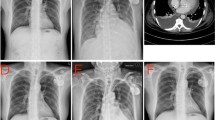Abstract
Myocardial contusion is a common complication of blunt chest injury. Severe heart failure and shock may result. The haemodynamic consequences of myocardial contusion in two patients are described; both received inotropic agents. In the first patient dobutamine was successful in improving myocardial function; dopamine had similar effects on the heart. In the second patient dopamine, preferred for its renal effects, produced a short-term improvement in myocardial function.
The rational use of pharmacological agents in this condition demands precise understanding of the underlying haemodynamic disturbances.
Similar content being viewed by others
References
Cane, R.D., Buchanan, N.: The electrocardiographic and clinical diagnosis of myocardial contusion. Intens. Care Med4, 99 (1978)
Editorial: Digoxin in sinus rhythm. Br. Med. J.1, 1103 (1979)
Editorial: Vasodilators in heart failure, Lancet1, 972 (1978)
Gewertz, B., O'Brien, C., Kirsh, M.M.: Use of the intra-aortic balloon support for refractory low cardiac output in myocardial contusion. J. Trauma17, 325 (1977)
Goldberg, L.I.: Cardiovascular and renal actions of dopamine: Potential clinical applications. Pharmacol. Rev.24, 1 (1972)
Hothersall, A.P., Waddell, G., Smith, H.C., Gilmour, D.G., Ledingham, I.McA.: Mobile intensive care II — secondary transport. In: Recent Advances in Intensive Therapy. Ledingham, I.McA. (ed.), p. 239. Edinburgh: Churchill Livingstone 1977
Kirsh, M.M., Sloan, H.: Blunt Chest Trauma. General Principles of Management, Boston: Little, Brown and Company 1977
Müller, H.: Efficiency of intra-aortic balloon pumping and external counterpulsation in the treatment of cardiogenic shock. In: Recent Advances in Intensive Therapy: Edinburgh Ledingham, I.McA. (ed.), p. 191 Edinburgh: Churchill Livingstone 1977
Polyani, M.L.: Fibreoptics in cardiac catheterisation I. Theoretical considerations. In: Dye Curves. Bloomfield, D.A. (ed.), p. 267. Baltimore: University Park Press 1974
Saunders, C.R., Doty, D.B.: Myocardial contusion. Surg. Gynecol. Obstet,144, 595 (1977)
Sonnenblick, E.H., Frishman, W.H., LeJemtel, T.H.: Dobutamine: a new synthetic cardioactive sympathetic amine. N. Engl. J. Med.300, 17 (1979)
Vasu, M.A., O'Keefe, D.D., Kadellakis, G.Z., et al.: Myocardial oxygen consumption and hemodynamic effects of dobutamine, epinephrine and isoproterenol. Fed. Proc.34, 435 (1975)
Author information
Authors and Affiliations
Rights and permissions
About this article
Cite this article
Macdonald, R.C., Hanning, C.D. & Ledingham, I.M. The use of inotropic drugs in myocardial contusion 2 case reports. Intensive Care Med 6, 19–23 (1980). https://doi.org/10.1007/BF01683076
Issue Date:
DOI: https://doi.org/10.1007/BF01683076




